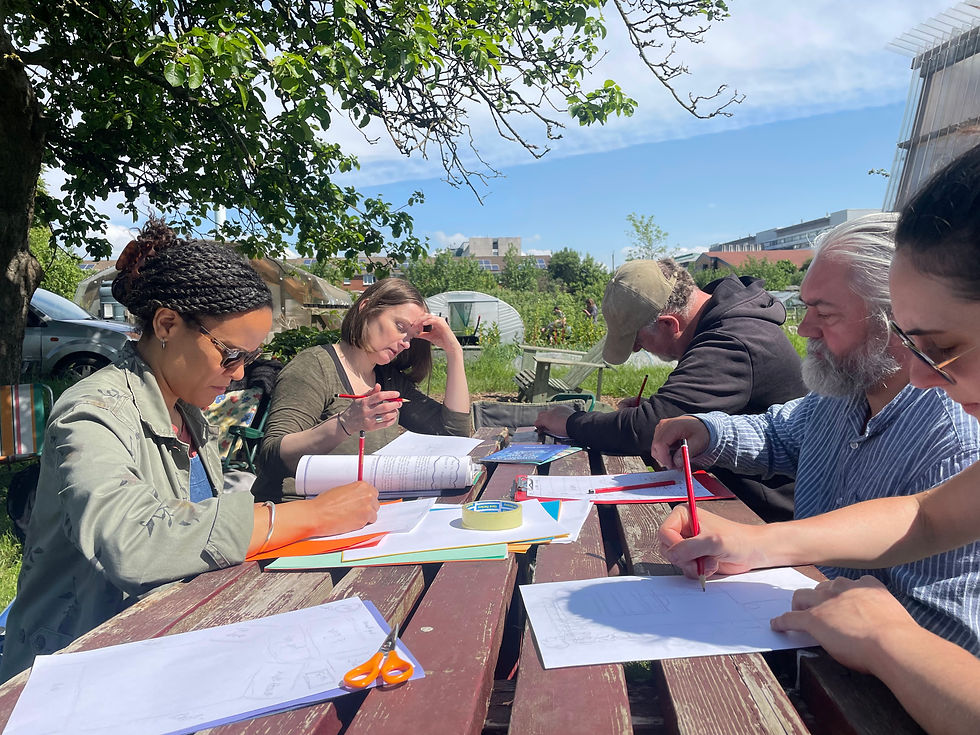GYO #5: INTEGRATING PERMACULTURE PRINCIPLES INTO YOUR GROWING SPACE
- Global Gardens
- Jan 16
- 4 min read
Updated: Jan 21
by Sally Hughes, Wild Cerdiwen

On a sunny Saturday in May, a group of us sat under the shade of the old Mother apple and took our time to explore how permaculture principles and design tools can help with designing a growing space. We learnt what permaculture design is, its roots and shoots. We took a deep dive into the permaculture principles and how we can apply them in our growing spaces. Then, we explored design tools that we can use to help us design our growing spaces; zones, sectors and observation.
Bill Mollison and David Holmgren are described as the co-founders of permaculture, beginning their collaboration in 1974, although many other folks have contributed to growing the movement, see here. The story that I like most about how permaculture developed is about Bill in the Tasmanian forest. Bill had worked as a forester and had observed the self-sustaining nature of forest ecologies, where the needs of the forest are met from within the forest, there are no external inputs and all outputs go back into the cycles of life, there is no waste.
He is recorded as saying “I believe that we could build systems that would function as well as this one does."2 I see now he was tapping, perhaps intuitively, into long held indigenous wisdom, arising from his observations. This self-sustaining forest ecology is what we understand today as circularity, a circular economy, or closed-loop system; the main goal of permaculture design is to create these kinds of systems.
Permaculture is a world-wide movement of folks who are interested in living more lightly with Earth. There are a range of techniques and approaches that have become synonymous with permaculture, such as herb spirals, chop and drop and food forests. But the movement is, as a whole, slightly different to permaculture design, which is a practice, a process we undergo in order to bring qualities to our decision making that support us to make choices that are good for us, good for others and good for Earth.
Permaculture design practice is grounded in ethics and principles which involves learning from the living world and indigenous wisdoms. Permaculture design uses creative processes and techniques to grow healthy, adaptable and resilient communities that support mutual flourishing for all beings.
The Ethics - Earth-care, People-care and Fair Share are the foundational pillars which guide our action towards caring for the earth, caring for people, growing reciprocity and limiting consumption in order to meet our human needs equitably, acknowledging the wealth and abundance available to us on the planet, which is our home.
During our session we explored the permaculture principles and three design tools; zones, sectors and observation.
Principles
When we apply the principles to our designs and decision making, we enact the ethics. The Principles are a demonstration of how the living world lives and ground our actions in ways of doing and being that are earth-conscious and foster interdependent relationships, giving rise to expression of the ethics in our designs in a holistic way. We use the principles as a lens to look through, as questions and as examples to guide action. The most commonly used Permaculture Principles are Holmgren’s 12, although there are many other sets.
Zones
This is a way of designing a growing space to maximise energy efficiency. Activities are put in different zones, depending on frequency of use, maintenance, visits etc. So you would put the lettuce and herbs you use everyday as close to the kitchen door as possible.
Generally, activities and structures are placed as follows:
Zone 00 - you, other people
Zone 0: Centre of activities - the house. This is high maintenance, high use and requires considerable investment of time and energy.Zone 1: Annual plants, herbs, compost, plant propagation, construction and maintenance, bike store and other high use activities, greenhouse. Often irrigatedZone 2: Dense planting, poultry and small livestock, orchard, polytunnels.Zone 3: Large water storage, main crops, sheep, cows, field shelters.Zone 4: Forestry, wood-pasture, dams, forage.Zone 5: Wild zone, where nature is in charge and where we go to learn and harvest only that which is abundant.
Sectors
Sector planning is concerned with energies external to our site, the elements and forces of the living world, that come from outside our growing space, and pass through it. Coming into awareness of the natural and uncontrollable influences, to mediate, mitigate or improve how these external forces affect your site. Examples of sectors include; sun, shade, water, wind, frost, slope, aspect, wild energies - noise, pollution, people…
We can use the information we gather in our sector analysis to make decisions, such as knowing where the wind is coming from will help place a laundry line and windbreaks.
Observation
To round up our day, we explored Global Gardens, using our observation skills to identify where we saw the 12 principles in action around the site! If you’re interested to learn more about observation as a design tool, Starhawk has created a beautiful resource, ‘9 Ways of Observing’.
If you’d like to learn more about permaculture design, Heather Jo Flores has created an abundant, beautiful and free resource at freepermaculture.com.
If you’re a book lover, like me, I’d recommend The Milkwood Permaculture Living Handbook.
Recent Posts
See AllThis is a recipe inspired by Cerys Matthews' Happy Foodie recipe. It is a slight twist on her recipe... Ingredients 2 Onions (finely...












Comments